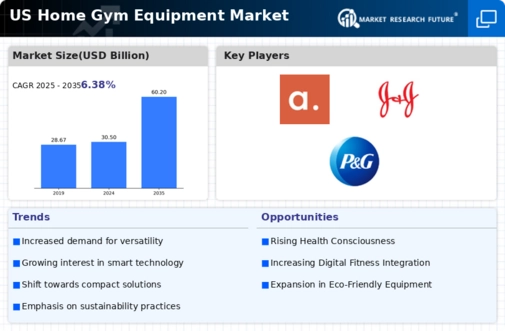The home gym-equipment market is currently characterized by a dynamic competitive landscape, driven by increasing consumer demand for fitness solutions that accommodate home environments. Key players such as Peloton (US), Nautilus (US), and Life Fitness (US) are strategically positioning themselves through innovation and digital transformation. Peloton (US), for instance, has focused on enhancing its digital platform, integrating advanced analytics to personalize user experiences, which appears to be a significant factor in maintaining customer loyalty. Nautilus (US) has emphasized product diversification, introducing a range of affordable yet high-quality equipment, thereby appealing to a broader demographic. Life Fitness (US) continues to leverage its strong brand heritage while investing in smart technology to enhance user engagement, collectively shaping a competitive environment that prioritizes innovation and customer-centric solutions.
In terms of business tactics, companies are increasingly localizing manufacturing to mitigate supply chain disruptions and optimize logistics. The market structure is moderately fragmented, with several players vying for market share, yet the influence of major companies remains substantial. This competitive structure allows for a variety of offerings, catering to diverse consumer preferences while fostering an environment ripe for innovation and strategic partnerships.
In October 2025, Peloton (US) announced a partnership with a leading health app to integrate fitness tracking features into its platform. This strategic move is likely to enhance user engagement by providing a more holistic approach to fitness, potentially increasing subscription retention rates. Such collaborations may also position Peloton (US) as a leader in the digital fitness space, aligning with current trends towards integrated health solutions.
In September 2025, Nautilus (US) launched a new line of smart home gym equipment that utilizes AI to provide real-time feedback and personalized workout plans. This innovation not only caters to the growing demand for connected fitness devices but also reflects a broader trend towards incorporating technology into traditional workout routines. The introduction of AI-driven features may significantly enhance user experience and satisfaction, thereby driving sales growth.
In August 2025, Life Fitness (US) unveiled a sustainability initiative aimed at reducing its carbon footprint by 30% by 2030. This commitment to sustainability resonates with a growing consumer preference for environmentally responsible products, potentially enhancing brand loyalty and attracting eco-conscious consumers. Such initiatives may also set a benchmark for competitors, pushing the entire industry towards more sustainable practices.
As of November 2025, the competitive trends in the home gym-equipment market are increasingly defined by digitalization, sustainability, and the integration of AI technologies. Strategic alliances are becoming more prevalent, as companies recognize the value of collaboration in enhancing product offerings and market reach. Looking ahead, competitive differentiation is likely to evolve from traditional price-based competition to a focus on innovation, technological advancements, and supply chain reliability. This shift suggests that companies that prioritize these areas will be better positioned to thrive in an increasingly competitive landscape.














Leave a Comment